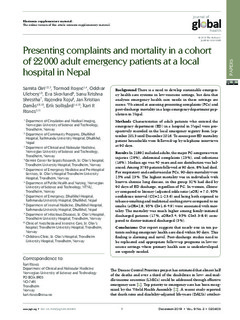| dc.contributor.author | Giri, Samita | |
| dc.contributor.author | Rogne, Tormod | |
| dc.contributor.author | Uleberg, Oddvar | |
| dc.contributor.author | Skovlund, Eva | |
| dc.contributor.author | Shrestha, Sanu Krishna | |
| dc.contributor.author | Koju, Rajendra | |
| dc.contributor.author | Damås, Jan Kristian | |
| dc.contributor.author | Solligård, Erik | |
| dc.contributor.author | Risnes, Kari R | |
| dc.date.accessioned | 2019-09-26T10:50:37Z | |
| dc.date.available | 2019-09-26T10:50:37Z | |
| dc.date.created | 2019-09-25T09:42:25Z | |
| dc.date.issued | 2019 | |
| dc.identifier.issn | 2047-2978 | |
| dc.identifier.uri | http://hdl.handle.net/11250/2618941 | |
| dc.description.abstract | Background
There is a need to develop sustainable emergency health care systems in low-resource settings, but data that analyses emergency health care needs in these settings are scarce. We aimed at assessing presenting complaints (PCs) and post-discharge mortality in a large emergency department population in Nepal.
Methods
Characteristics of adult patients who entered the emergency department (ED) in a hospital in Nepal were prospectively recorded in the local emergency registry from September 2013 until December 2016. To assess post-ED mortality, patient households were followed-up by telephone interviews at 90 days.
Results
In 21892 included adults, the major PC categories were injuries (29%), abdominal complaints (23%), and infections (16%). Median age was 40 years and sex distribution was balanced. Among 3793 patients followed at 90 days, 8% had died. For respiratory and cardiovascular PCs, 90-day mortality were 25% and 23%. The highest mortality was in individuals with known chronic lung disease, in this group 32% had died by 90 days of ED discharge, regardless of PC. In women, illiteracy compared to literacy (adjusted odds ratio (aOR) = 7.0, 95% confidence interval (CI) = 2.1-23.6) and being both exposed to tobacco-smoking and traditional cooking stove compared to no smoke (aOR = 2.8, 95% CI = 1.6-4.9) were associated with mortality. The mortality was much higher among family-initiated discharged patients (17%, aOR = 5.4, 95% CI = 3.3-8.9) compared to doctor-initiated discharged (3%).
Conclusions
Our report suggests that nearly one in ten patients seeking emergency health care died within 90 days. This finding is alarming and novel. Post-discharge studies need to be replicated and appropriate follow-up programs in low-resource settings where primary health care is underdeveloped are urgently needed. | nb_NO |
| dc.language.iso | eng | nb_NO |
| dc.publisher | Edinburgh University Global Health Society | nb_NO |
| dc.rights | Navngivelse 4.0 Internasjonal | * |
| dc.rights.uri | http://creativecommons.org/licenses/by/4.0/deed.no | * |
| dc.title | Presenting complaints and mortality in a cohort of 22 000 adult emergency patients at a local hospital in Nepal | nb_NO |
| dc.type | Journal article | nb_NO |
| dc.type | Peer reviewed | nb_NO |
| dc.description.version | publishedVersion | nb_NO |
| dc.source.volume | 9 | nb_NO |
| dc.source.journal | Journal of Global Health | nb_NO |
| dc.source.issue | 2 | nb_NO |
| dc.identifier.doi | https://dx.doi.org/10.7189%2Fjogh.09.020403 | |
| dc.identifier.cristin | 1728669 | |
| dc.description.localcode | © Author(s) 2019. This work is distributed under the Creative Commons Attribution 4.0 License. | nb_NO |
| cristin.unitcode | 194,65,25,0 | |
| cristin.unitname | Institutt for sirkulasjon og bildediagnostikk | |
| cristin.ispublished | true | |
| cristin.fulltext | original | |
| cristin.qualitycode | 1 | |

